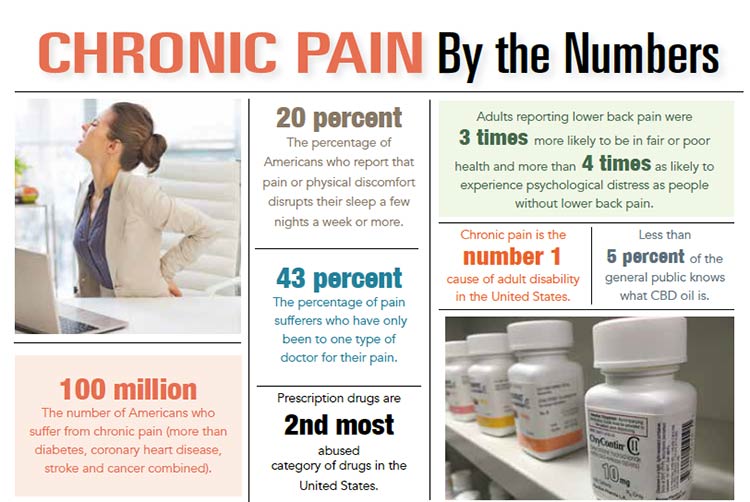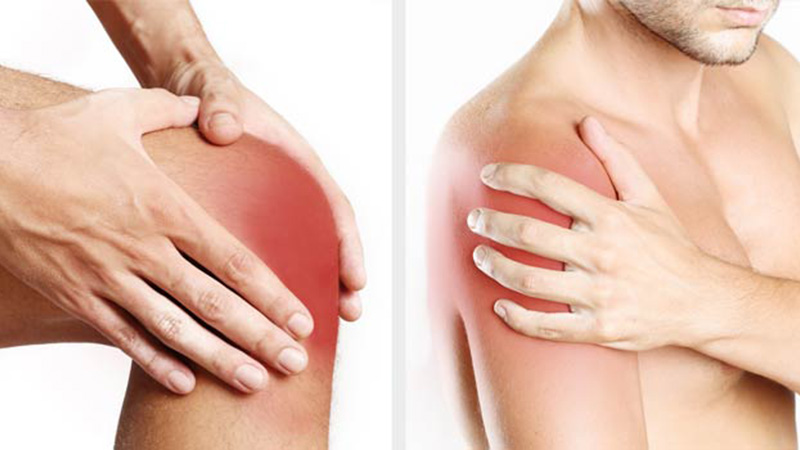One in every three Americans is plagued by chronic pain, which is commonly defined as a pain that has persisted for six months or more. It can come in the form of back aches, headaches, joint pain, sinus pain or pain in specific body parts and can morph between dull or debilitating, constant or intermittent, manageable or excruciating.
Almost all who specialize in pain management agree that the first step in finding relief is to diagnose the source of the pain. Sometimes it’s as obvious as the place where pain is felt, but often pain is connected through your nervous system and stems from somewhere else in the body. It can even be created in your brain due to outside factors such as stress. As complex as the source of the pain can be, there are many options to treat it.
The use of medications to ease chronic pain is still common, but the increased awareness of the addictive properties of many medications and the side effects that accompany them have encouraged pain sufferers to seek other options for treatment.
Nerve blocks and steroid injections offer fast relief, often in an outpatient setting.
“We begin with a very conservative approach: stabilizing the muscles with support to the bones to prevent further wear and tear, and finding out what is causing pain,” explained Dr. Dan Nemeth of Signe Spine and Rehab. “Diagnostic injections help us determine the source of the pain, and then we perform target injections at trigger points to ease pain.”
These injections can be nerve blocks, epidural steroid injections, Botox, platelet rich plasma injections and more, depending on where the pain is and what is causing it.
The most common types of back problems Dr. Nemeth sees are disk pain, facet pain, muscular pain and pain in the sacroiliac joint. His patients who report radiating pain down their arms and legs often are experiencing disk herniation.
“Injections can reduce inflammation. Once that is calmed down, we stress for patients to practice neutral stabilization like leg lifts, bridging and planks, as opposed to something more stressful on the spine like crunches. We encourage them to start physical therapy to be on the road to better health,” said Dr. Nemeth.
Other pain sufferers choose exercise to work through the pain. Low impact moves and breathing patterns through programs such as yoga and Pilates, under the guidance of a professional who understands the body and sources of pain, are popular.
“Your body adjusts to pain that is consistently there, and many times the tension of the anticipation of it is worse than the pain itself, and your body tenses up,” said Claudia Interrante, a registered yoga teacher. “To find relaxation through breath work and meditation has shown to help with that anxiety and relaxes the whole body so the pain is not as severe.”
While pain tolerance is different for each individual, the pain from stress-related migraines, back problems or even natural childbirth can be managed at certain levels through concentrated breathing and stretching.
For many people, however, the root of the problem lies deeper than injections or yoga can reach.
“Changes can happen in the brain that affect nerves wired throughout the body. For example, if you simply have a bad day, these changes send messages from your brain to your nervous system to cause pain,” explained Rebecca Dyches, PT, MS, of Rebecca’s Physical Therapy. “Eventually these become seared into the nervous system, and your brain reacts consistently with pain each time you have a bad day.”
The same is true for complex regional pain syndrome or phantom limb pain – the brain can create pain when there is no true injury.
Through brain exercises and sometimes sympathetic nervous system stimulation, depending on the problem, Dyches said the goal is to retrain the part of the brain responsible for the painful reaction.
“The brain is so complex, there is no one answer for pain sufferers. For some, simple meditations like praying, music or going for a walk can help. In other cases, explaining how their brain reacts to certain stimulations helps patients overcome it,” said Dyches. “We put together a set of activities to do the minute you feel pain. Even if the pain persists, that pathway from brain to nerves is being broken down, and repeating those activities each time will allow the brain to develop an alternative pathway that does not lead to pain.”
For those seeking natural solutions for inflammation, medical marijuana remains illegal in South Carolina, but a lesser-known derivative is legal in all 50 states.
“Eucalyptus Wellness helps their customers manage pain with a variety of natural products, including CBD oils and salves. CBD is a component of the cannabis plant and can be applied topically or ingested. It is a great product that helps reduce inflammation,” said Janis Emplit of Eucalyptus Wellness.
CBD products can be purchased over the counter, and Eucalyptus Wellness staff are available to help find the right option for you. For those on the go, the store’s Elixir Bar even has a Cannabis Shot drink, among many other exotic drinks, elixirs and tonics. Served with 20 mg of CBD oil, your choice of juice and an orange wedge, Emplit said the shot helps with anxiety and stress, and, while it eases pain for some people, others find better relief when the CBD is in their bloodstream.








